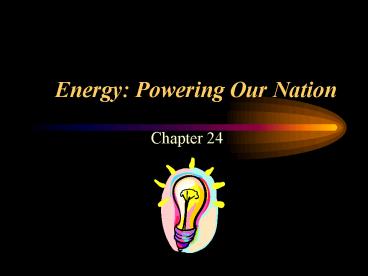Energy: Powering Our Nation PowerPoint PPT Presentation
1 / 16
Title: Energy: Powering Our Nation
1
Energy Powering Our Nation
- Chapter 24
2
Why do you think Canada would be the highest user
of energy in the world?
- Cold climate
- Spread out population high transportation costs
- Industrial Economy
- Energy is cheap so we tend to waste it!
3
Energy Sources
- Conventional Energy Sources
- Natural Gas, Coal, Hydro and Nuclear Energy
- Alternative Energy Sources
- Solar, Wind, Biomass Energy
4
Energy Terminology
- To compare different forms of energy we need a
common unit of measure - The basic unit to measure energy is the joule (J)
- One joule is a tiny amount of energy
- Usually energy is reported in gigajoules which
equal one billion joules or pentajoules which
equal one million gigajoules
5
Oil and Gas
- Oil and gas are found together
- How they formed
- Millions of years ago parts of Canada was covered
with shallow seas. - Dead plants and animal fell to the sea floor
- Eventually the sea evaporated and sediments
formed layer on top of the dear plants and
animals - The pressure from all the layers of sediment
converted the plant and animal mater into oil and
gas
6
(No Transcript)
7
Finding Oil and Gas
- It is hard find oil and gas deposits because they
are buried so deep - Geologists use the following tricks to find the
deposits - Look for rocks on the surface that have traces of
oil - Search for fossils
- Conduct seismic surveys that use shock waves
8
Drilling for oil and gas
- Determining if oil and gas are where you think it
is can only be done by drilling - Its costly and time consuming
- There are three results of drilling
- No oil or gas
- Oil and gas are found but
there is not enough to
justify the
cost of extraction and
transport - The deposit is large enough to develop
9
Collecting the Oil and Gas
- Removal of oil from the ground proceeds in one of
two ways - Flowing Wells there is enough natural pressure
to force the oil or gas to the surface. The flow
at the surface is controlled by a series of
valves called a Christmas tree - Non-flowing wells electric or gas powered pumps
are used to get the oil or gas to the surface
10
Canadas Oil and Gas
- Most production comes from the western part of
the Boreal Plains and Prairie Ecozones - Production comes from conventional crude oil that
is pumped from the ground and from oil sands.
11
Oil Sand
- Oil sand is an area that has bitumen covering
individual particles of sand - Bitumen is an oil-like substance
- The oil sand is easily dug up but then it is hard
to get the oil separated from the sand - Expensive process
- As conventional deposits get used up the
extraction of the oil from the oil sands will
increase
12
Electricity
- Most electrical energy comes from a generator
- Generators convert mechanical energy into
electrical energy - In Canada there are three main ways that this
mechanical energy is produced - Moving water Hydro Electric Generating Stations
- Expanding steam Thermal Electric Generation
Plants - Expanding Steam Nuclear Electric Generating
Stations
13
Thermal Electricity
- The steam that is used to move the turbine is
created by burning fuel like coal, oil, natural
gas, wood, etc. - Advantages
- Plants can be built where the energy is needed
therefore there are short transmission lines - Plants are relatively cheap to build
- Disadvantages
- Fuel costs are high
- Most of the fuels used are non-renewable
- Carbon dioxide is produced
14
Nuclear Electricity
- The steam that is used to turn the turbines comes
from the heat created by nuclear fission. - Nuclear fission is the radioactive breakdown of
uranium atoms
15
Nuclear Electricity
- Advantages
- Plants can be built where energy is needed
- Low operating costs
- We have lots of uranium in Canada
- Normally they do not produce air pollution
- Disadvantages
- High construction costs
- Radioactive materials are very harmful to humans
- Waste products remain dangerous for 100 000 yrs
- Plants need to be rebuild relatively often
16
Getting the Electricity to Market
- Often electricity is transmitted 100s of kms to
where the people that need it are - The generating systems direct their electricity
to power grids - The customers then take the electricity from the
grid. - Provinces and states in North America have grids
that are all connected therefore electricity
becomes a commodity that can be exported for
profit

